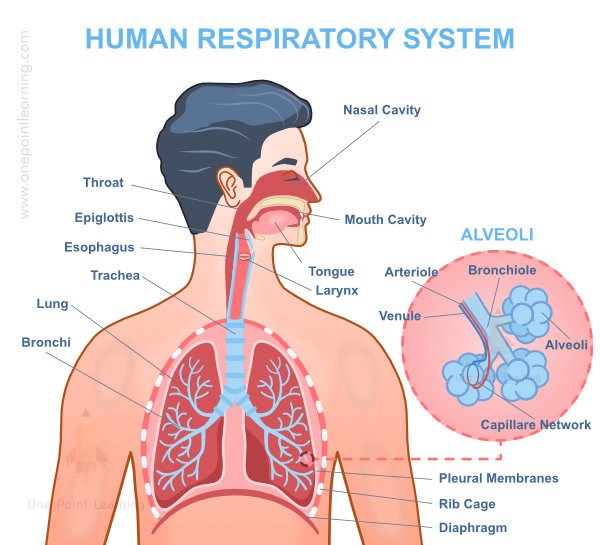In this Class 7 Science chapter 9, we explore two important Life Processes in Animals —nutrition and respiration.
Animals, including humans, need food for energy. But before the body can use food, it must be broken down into simpler forms through digestion. This process happens in a long tube called the alimentary canal, which includes the mouth, stomach, intestines, and associated organs like the liver and pancreas. Interestingly, different animals have developed unique ways of digesting food based on what they eat—such as rumination in cows and the gizzard in birds.
Along with nutrition, animals also need oxygen to release energy from food through a process called respiration. Humans and many land animals use lungs for breathing, while fish use gills, and some animals like earthworms breathe through their skin. This chapter helps us understand how breathing and respiration are different, how gases are exchanged in the lungs, and how energy is produced inside cells.
Through diagrams, activities, and real-life examples, this chapter encourages us to observe and understand the fascinating inner workings of animals’ bodies—and how these processes keep them alive and active.
Life Processes in Animals Worksheet
Our worksheets provides a wide variety of practice questions such as MCQs, fill in the blanks, true or false, and short & long answer questions. Aligned with the latest curriculum our worksheet encourages critical thinking through concept-based activities, experiments, and real-life applications. With our engaging and well-structured worksheets, students can reinforce their classroom learning, prepare for exams, and develop a strong foundation in science.
Through simple observations and activities, this chapter helps us understand:
- Understand what life processes are and why they are essential for animals.
- Study the structure and function of the human digestive system.
- Discover how digestion varies in animals like cows (ruminants) and birds.
- Learn the difference between breathing and respiration.
- Explore the structure of the human respiratory system and how gas exchange happens in the lungs.
- Understand how oxygen helps break down food to release energy during respiration.
- Discover the different breathing mechanisms used by various animals like fish (gills), frogs (lungs and skin), and earthworms (skin).
- Recognize how the circulatory system transports oxygen and nutrients throughout the body.
This chapter builds a strong foundation for understanding two essential life processes in animals — nutrition and respiration.
Also download:
Class 7 Science Worksheet Curiosity
Class 7th Science NCERT Solutions Curiosity
Science Class 7 chapter 9 Study Notes
Key Life Processes
- Nutrition, respiration, excretion, reproduction – essential for survival.
- Animals obtain energy from food, broken down into simpler components during digestion.
Digestion in Humans
- Mouth: Mechanical digestion (chewing), saliva breaks starch into sugar.
- Oesophagus: Moves food to stomach using wave-like contractions (peristalsis).
- Stomach: Proteins digested; acid kills bacteria; mucus protects the lining.
- Small Intestine: 6 meters long, receives bile (from liver), pancreatic juice, and intestinal juice; nutrients absorbed into blood through villi.
- Large Intestine: Absorbs water and salts; undigested waste (stool) expelled through the anus (egestion).
Digestion in Animals
- Ruminants (e.g. cows): Chew cud (rumination).
- Birds: Use gizzard to grind food.
- Digestion method varies with diet and structure of digestive system.

Respiration in Humans
- Breathing: Physical process of inhaling (oxygen) and exhaling (CO₂).
- Respiration: Chemical process where glucose + oxygen → CO₂ + water + energy.
- Organs: Nostrils → Nasal passages → Windpipe → Lungs → Alveoli.
- Exchange of gases occurs in alveoli.
Respiration in Other Animals
- Birds, mammals, reptiles: Lungs.
- Fish: Gills extract oxygen from water.
- Frogs: Gills (tadpole), lungs & skin (adult).
- Earthworms: Moist skin.
Class 7 Science chapter 9 Fill in the Blanks
- The process of breaking down complex food into simpler forms is called ______________.
- The finger-like projections in the small intestine are called ______________.
- The process of removing waste from the body is called ______________.
- ______________ bring back partially digested food to chew again.
- In humans, ______________ are the site of exchange of gases.
Life Processes in Animals Question Answers
Q: What is digestion?
A: Digestion is the process of breaking down complex food substances into simpler forms that can be absorbed by the body.
Q: What is the function of saliva in digestion?
A: Saliva contains enzymes that break down starch into sugar and also moistens the food for easier swallowing.
Q: What is peristalsis?
A: Peristalsis is the wave-like movement of the food pipe that pushes food from the mouth to the stomach.
Q: Name the digestive juices secreted by the stomach.
A: The stomach secretes gastric juice, which includes digestive enzymes, hydrochloric acid, and mucus.
Q: How does digestion occur in birds?
A: Birds lack teeth. Their food is broken down in the gizzard using muscular contractions and grit (small stones) swallowed by them.
Q: What is respiration?
A: Respiration is the chemical process in which glucose is broken down using oxygen to release energy, with carbon dioxide and water as by-products.
Q: How does breathing differ from respiration?
A: Breathing is the physical process of inhaling and exhaling air, whereas respiration is the chemical process of producing energy from glucose and oxygen inside cells.